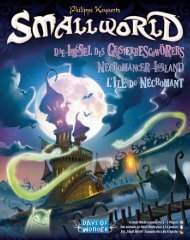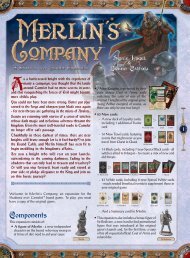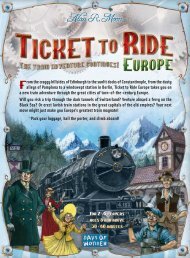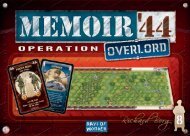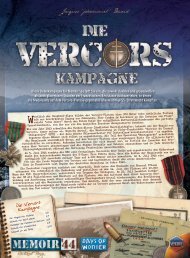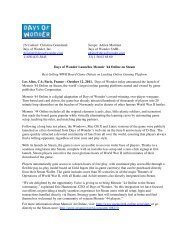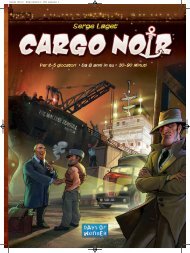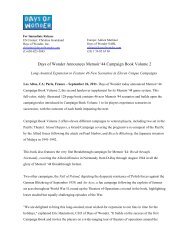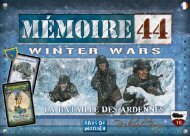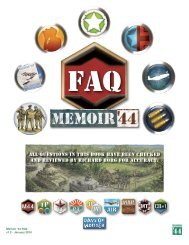Create successful ePaper yourself
Turn your PDF publications into a flip-book with our unique Google optimized e-Paper software.
1Welcome to the second expansion forMemoir '44: The Eastern Front.ForewordFrom the frozen shores <strong>of</strong> Lake Ladoga to the burning ruins <strong>of</strong> Stalingrad, relive some <strong>of</strong> the most intense battles <strong>of</strong> WWII,where entire Army groups disappeared faster than a single battalion on the beaches <strong>of</strong> Normandy.This expansion follows Expansion one, the Terrain Pack. While the Terrain Pack focused on new terrain and <strong>rules</strong>, theEastern Front expansion is devoted to the ferocious battles that pit the Axis and Soviet forces against each other. Also includedis a scenario drawn from the Russian-Finnish war, and an Overlord scenario <strong>of</strong> what turned out to be the largest tank battlein history: Kursk.This pack is independent from the Terrain Pack and from expansion three - The Winter/Desert board map, which are notrequired to play the Eastern Front battles. Throughout, we have used the appropriate board (Winter board during Winterscenarios) in the depiction <strong>of</strong> each scenario, but purely for visual purposes. For the ultimate gaming experience, you mayalso consider buying our "Winter/Desert Board Map" expansion. Otherwise, you may play with the standard country-sideMemoir '44 board.For Memoir '44 enthusiasts who own both expansions, we have thrown in a "bonus" 8th scenario that combine themall. You will find this scenario at the end <strong>of</strong> this booklet.Make sure you visit the game web site at www.memoir44.com. As with all <strong>Days</strong> <strong>of</strong> <strong>Wonder</strong> games, you will find plenty<strong>of</strong> resources: additional <strong>rules</strong>, new scenarios, forums, etc. The Memoir '44 community is extremely active and very helpfulto new players.And above all, have fun and enjoy!Richard Borgand the platoon at <strong>Days</strong> <strong>of</strong> <strong>Wonder</strong>
2TABLE OF CONT<strong>EN</strong>TSI. NEW TERRAIN TILESTrenches, City Ruins,Russian Villages, Winter Forest p.2Ravine, Mashes, Hill with ForestHill with Village, Frozen RiverFactory Complex p.3II. NEW RULESRussian Command <strong>rules</strong> p.3Blitz Rules p.4III. NEW MEDALSHero <strong>of</strong> the Soviet Union p.4Minefields p.4Battle Star Tokens p.5IV. NEW OBSTACLESWinter Field Bunkers p.5Dragon's Teeth p.5V. NEW BADGESSniper p.5Russian Elite p.6Combat Engineers p.6Cavalry p.6Finnish Ski Troops p.6PAGE REFER<strong>EN</strong>CES:A page number written like this: M44 p.7indicates page 7 inside the original <strong>rules</strong> book<strong>of</strong> MEMOIR '44.A page number written like this: p.9 indicatespage 9 inside this booklet.This icon indicates that we areintroducing a new rule toMEMOIR '44.I. NEW TERRAIN TILESTrenches◆ Movement: An Infantry or an Armor unit that moves onto a Trench hex must stop andmay not move further on that turn. A Trench is impassable to Artillery.◆ Battle: An armor unit on a Trench hex may not battle. When battling an enemy unitthat is on a Trench hex, Infantry and Armor reduce the number <strong>of</strong> Battle dice rolled by 1,and Artillery Battle dice are not reduced.An Infantry unit in Trenches may ignore the first flag rolled against it.◆ Line <strong>of</strong> Sight: Trenches do not block line <strong>of</strong> sight.City RuinsBy default, City Ruins have the same effect as a Town & Village hex (M44 p.14).In addition, a unit on a City Ruins hex may ignore the first flag rolled against it. OnlyInfantry units may enter a City Ruins hex.Russian VillagesRussian Villages have the same effect as a Town & Village hex (M44 p.14).Winter ForestA Winter Forest hex has the same effect as a Forest hex (M44 p.13), and is used here forbetter visual effect.
3Ravine◆ Movement: Impassable to Armor and Artillery.No movement restrictions for Infantry.◆ Battle: No combat restrictions. An Infantry unit ona Ravine hex may ignore the first flag rolled against it.◆ Line <strong>of</strong> Sight: A Ravine does not block line <strong>of</strong> sight.Marshes◆ Movement: An Infantry or Armor unit that movesonto a Marsh hex must stop and may not move furtheron that turn. A unit that leaves a Marsh hex may onlymove onto an adjacent hex. An Artillery unit may notenter a Marsh hex.◆ Battle: An Infantry unit on a Marshhex does not have any battle restrictions. An Armor unit may notbattle, the turn it moves onto, or out <strong>of</strong>, a Marsh hex. An Armorunit that makes a successful Close Assault Combat on a unit in aMarsh hex may Take Ground but may not make an Armor Overrun.◆ Line <strong>of</strong> Sight: A Marsh hex does not block line <strong>of</strong> sight.Note: although these marshes are snowy, they are played exactlylike the ones in the Terrain Pack expansion.Hill with Forest, Hill with VillageThese terrains hexes are used for visual effect only. TheHill on Forest has the same effect as a Forest (M44 p.13),and the Hill with Village has the sameeffect as a Village (M44 p.14).Frozen RiverThe river is frozen and may be crossed. The ice, however,in some parts is not thick, nor safe. Whenever a unitmoves or retreats onto a Frozen Riverhex, roll two battle dice. For each Starrolled, 1 figure is lost. There are no othermovement or battle restrictions.II. NEW RULESFactory ComplexSee specific scenario <strong>rules</strong> for Factory Complex. Bydefault, it has the same effect as a Town & Village hex(M44 p.14).POLITICAL COMMISSARStalin's paranoia <strong>of</strong> any potential rivals resulted in thepurge <strong>of</strong> some <strong>of</strong> the best and brightest <strong>of</strong>ficers in theRed Army in 1937-1938. Those who remained were timidleaders or groveling "yes-men" to their politicalcommissars. In the heat <strong>of</strong> the most ferocious battles,soldiers were <strong>of</strong>ten forced into combat under the gun<strong>of</strong> their own unit's political commissar.Russian Command <strong>rules</strong>Deal Command cards to each side per the scenario's briefing notes.The Russian player must then select one card from his hand andplace it under the Commissar Chip. The Command card under the
4Commissar Chip is the Command card he will play on his next turn. When theRussian player takes his turn, he selects one card from his hand to be placedunder the Commissar Chip and takes the card that is under the Commissar Chipand plays it as his Command card this turn. At the end <strong>of</strong> his turn, the Russianplayer draws a new Command card into his hand as normal.On the Russian player's turn, in lieu <strong>of</strong> playing the Command card alreadycommitted under the Commissar Chip, the Russian player may choose to playfrom his hand a 'Recon 1' Command card or a 'Counter-Attack' Command card.The Command card under the Commissar Chip is not used and remains under thetoken until the next turn. The Russian player may also play the Ambush card fromhis hand per the standard <strong>rules</strong>.BLITZ RULESScenarios occurring in the early years <strong>of</strong> WWII <strong>of</strong>ten use the BlitzRules .◆ The Axis player may play a 'Recon 1' card as an Air Power Tactic cardin that section (at least one target hex must be in the section): targeta group <strong>of</strong> 4 or fewer enemy units adjacent to each other. Roll 1 battledice per hex (Axis air attack).◆ Armor movement is amended as follows: An ordered Axis armorunit may move up to 3 hexes and battle while an ordered Allied armorunit may only move up to 2 hexes and battle.III. NEW MEDALSHero <strong>of</strong> the Soviet Union MedalThis medal was the highest degree <strong>of</strong> distinction in the formerUSSR. Created in 1934, it was awarded to over 12,500 people,mostly during the 1941-1945 war between Germany and theSoviet Union (called "The Great Patriotic War" by the Russians).MinefieldsThe scenario briefing notes indicate which side will layMinefields out.Minefields are set up on the board at the same time as terrain hexes. Beforeplacing any Minefield, set all Minefield pieces with their picture <strong>of</strong> the landmine face up. Mix the pieces. Now place one Minefield piece, selected at random,face up (numbered side hidden) on each Minefield hex indicated by the scenario.Return any unused Minefield pieces to the box, their numerical face still hiddenfrom the players’ view.When entering a Minefield, a unit must stop and may not move any further onthat turn.If the unit entering the Minefield is an enemy unit, turn the Minefield pieceover to reveal its strength number. If the Minefield is a decoy (“0” strength),remove it from the board. Otherwise, roll a number <strong>of</strong> Battle dice equal to theMinefield’s strength. Score 1 hit for each die matching the unit’s symbol or agrenade. Ignore all other symbols, retreat flag included. After any explosion,the Minefield remains in effect, its strength face up and visible to both players.If the unit entering the Minefield is a friendly unit (i.e. a unit that belongs tothe player who laid the Minefield down), the unit must still stop, but will ignorethe Minefield, never revealing it, if hidden, nor rolling dice.Note: In accordance with the general <strong>rules</strong> <strong>of</strong> retreat, a Minefield hasno effect on retreat moves. Therefore, a retreating unit may movethrough a Minefield without stopping. Retreating units that move ontoor through a Minefield do not roll for hits.
5BATTLE STAR TOK<strong>EN</strong>SBattle Star tokens are generic tokens used to denote specialeffects, unique events, actions or triggers associated with a giventerrain hex or unit for the duration <strong>of</strong> a scenario.Many Battle Star effects are described in the Terrain Packexpansion, because <strong>of</strong> all the special terrains and landmarks that can be foundin that expansion.Use <strong>of</strong> the Battle Star tokens is indicated in the Special Rules <strong>of</strong> scenarios.CamouflageWhen the scenario indicates it, a Battle Star token may be usedto mark units with camouflage.You may only target a camouflaged enemy unit in a Close Assaultcombat (adjacent hex).A camouflaged unit must remove its Battle Star if it battles or moves becauseit loses its Camouflage.IV. NEW OBSTACLESAND TOK<strong>EN</strong>SWinter Field BunkersSame effect as a Bunker (M44 p.16).In addition, either side may claim it as a defensiveposition.Dragon's Teeth◆ Movement: Only Infantry may enter a Dragon'sTeeth hex. An Infantry that enters a Dragon's Teethhex must stop and may not move further on that turn.◆ Battle: No combat restrictions.◆ Line <strong>of</strong> Sight: A Dragon's Teeth hex does not block line <strong>of</strong> sight.V. NEW BADGESSniperPlace a single Infantry figure and a Sniper Badge inthe hexes indicated in the scenario.A Sniper is ordered like an Infantry unit.An ordered Sniper:◆ May move like a Special Forces infantry unit, 1 or 2 hexes and battle.◆ May battle when he moves onto terrain type (woods, towns,etc.) where standard infantry could not battle. He must still stopand move no further in any terrain that limits movement.◆ May retreat up to 3 hexes instead <strong>of</strong> the standard 1 hex on anyretreat flag rolled.An ordered Sniper unit may target an enemy infantry or artillery unit 5 or fewerhexes away. It must have line <strong>of</strong> sight to its target. A Sniper's battle dice are notreduced when targeting an enemy unit in terrain. A Sniper will roll 1 die in combatand scores one hit on a target symbol, Grenade or Star symbol rolled. A flag willcause the target unit to retreat as normal. A Sniper cannot target an armored unit.A Sniper may be targeted as normal but only a Grenade symbol will score a hit.The Sniper is removed when hit and does not count as a medalNote: If a Sniper is adjacent to an enemy unit it must combat theadjacent unit. If the only adjacent unit is a tank, which a Sniper cannottarget, the sniper must move before he may battle.
6Combat EngineersCombat Engineer units were used throughout WWII to increasethe combat effectiveness <strong>of</strong> the Corps. They provided mobility,counter−mobility, survivability, topographic and engineeringsupport.An Engineer unit moves and battles like a Standard unit. However:◆ In Close Assault Combat, an Engineer unit ignores all terrain Battledice reductions, i.e. their enemies are not protected by their terrain.◆ An Engineer unit that is on a hex with wire will reduce the number<strong>of</strong> Battle dice it rolls by 1 and may also remove the wire from the hexon the same turn.◆ An Engineer unit that moves onto a Minefield hex and that iseligible to battle must clear the Minefield hex instead <strong>of</strong> battling. Ifthe Engineer unit cannot clear the Minefield, it detonates.CavalryThe Infantry with a Cavalry badge are Cavalry units.Place 4 Infantry figures and a Cavalry Badge in the hexes asindicated in the scenario.A Cavalry unit is ordered like a regular infantry unit.An ordered Cavalry unit:◆ May move up to 3 hexes and battle.◆ May battle any enemy target 2 orfewer hexes away. It rolls 2 dice inClose Assault and 1 die against a targetat 2 hexes.◆ May, on a successful Close Assault Combat, take ground and battleagain, using the same <strong>rules</strong> as the Armor Overrun Combat (see M44p.11).Russian EliteUse this badge to indicate Russian Special Units.Finnish Ski TroopsThe Finnish Special Forces Infantry are Ski troop units. Place aFinnish badge in the same hex with these units to distinguishthem from the other units. These units only have 3 figures. Anordered Ski unit:◆ May move up to 3 hexes and battle. It rolls 3 dice in Close Assaultand 2 dice against a target unit 2 hexes away.◆ May battle when the unit movesonto terrain type (woods, towns, etc.)where standard infantry could notbattle. The unit must still stop andmove no further in terrain that limits movement.◆ May retreat up to 3 hexes instead <strong>of</strong> the standard 1 on any retreatflag rolled.
38 - [RUSSO-FINNISH WAR] SUOMUSSALMI -DECEMBER8-16, 1939Setup order1x72x103x16Frozen Lake4x2Field Bunker56x7x1HulkoniemiSuomussaimiMakinen’sRoadblockFrozen Lake78x2x7Frozen LakeFrozen LakeFrozen Lake
8Historical BackgroundThe Soviet Army crossed the border into Finland in the last days <strong>of</strong> November, 1939. On December 8th, they reached the lightlydefended village <strong>of</strong> Suomussalmi. The next day, Colonel Hjalman Siilasvuo, a veteran <strong>of</strong> WWI, brought in reinforcements andtook command <strong>of</strong> the Finnish defenses. His mission was to destroy the Russian forces and force them out <strong>of</strong> the village - a tallorder, as the enemy was well supplied and numerically superior. One <strong>of</strong> Siilasvuo's first orders was for Captain J. A. Makinen toset up a roadblock to slow the continuing advance <strong>of</strong> the Russian 44th Division. While the roadblock operation was beingdeveloped, Siilasvuo launched an attack against the Russian positions in and around Suomussalmi. The Soviets, however weretoo well entrenched and little headway was made in the first few days <strong>of</strong> the battle.In time, the Finnish ski troops, fighting on home ground, were able to slowly tighten the ring around the villages and by thefirst week <strong>of</strong> January had defeated the larger Soviet force.The stage is set, the battle lines are drawn, and you are in command. The rest is history.BriefingFinnish Player◆ Take 6 Command cards.◆ You move first.Russian Player◆ Take 4 Command card.Conditions <strong>of</strong> Victory◆ 6 Medals.If Finnish units occupy 3 <strong>of</strong> the 4 town hexes at the end <strong>of</strong> theirturn, they win immediately.Special RulesThe Air Power card is played as an Artillery Bombard Tactic card:'Artillery battles twice or moves up to 3 hexes'.The bunker is a Field Bunker (p.5).The River represents the Frozen lakes in the area. Refer to p.3about frozen rivers.The Finnish Special Forces Infantry are Ski troop units. Place aFinnish badge in the same hex with these units to distinguish themfrom the other units. These units only have 3 figures. See p.6 formore details about Ski Troops.Russian Command <strong>rules</strong> are in effect (see p.3).
39 - [TYPHOON] GATES OF MOSCOW -OCTOBER18, 1941Setup order1x42x15345x9x6x2Bryansk67x2x2OrelKalugaVyazmaMozhaiskRzhev8x29x5
10Historical BackgroundIn October, the German High Command launched the final <strong>of</strong>fensive <strong>of</strong> 1941 - Operation Typhoon. The initial German success onthe Eastern Front had put them deep into the Soviet Union on all fronts, but the advance slowed before they could reach the keycities <strong>of</strong> Mother Russia. The Soviets used their large population to continuously produce more military forces. Although poorlyequipped and inexpertly led, the Soviet soldiers were deployed in a last desperate line <strong>of</strong> defense to keep the German armyfrom reaching Moscow.Mozhaisk, the last major town on the direct road to Moscow was captured but the German advanced stalled. The exhausted armyhad no additional reserves for the final push on into Moscow.The stage is set, the battle lines are drawn, and you are in command. The rest is history.BriefingAxis Player◆ Take 5 Command cards.◆ You move first.Russian Player◆ Take 5 Command cards.Conditions <strong>of</strong> Victory◆ 7 Medals.An Axis unit that captures the East bridge or the town <strong>of</strong> Mozhaiskcounts as one Victory Medal. Place an Objective Medal on eachhex. As long as the Axis unit remains on the Bridge or Town hex,it continues to count toward the Axis victory. If the unit moves<strong>of</strong>f or is eliminated, it no longer counts.Special RulesBlitz Rules are in effect (see p.4).Russian Command <strong>rules</strong> are in effect (p.3).
12Historical BackgroundWhen the German <strong>of</strong>fensive against Moscow came to a halt on December 6, 1941, the 1st Panzer Division was ordered to Klinwith the mission <strong>of</strong> keeping the town open for the withdrawal <strong>of</strong> other German formations. It succeeded in holding the junctionagainst persistent Russian attacks until German forces completed their retreat. As the 1st Division began their own withdrawalto Nekrasino, it found the Russian forces had surrounded the town. A bold plan was devised that called for a feint toward nearbyGolyadi supported by artillery. If the Russians reacted as hoped, the main breakout to Nekrasino could then take place.The intended deception was a complete success. The Russians around Golyadi were surprised and reserves were rushed to thetown. The main breakout was then lead by German combat engineers. With artillery support, the breakout force fought its waythrough to Nekrasino.The stage is set, the battle lines are drawn, and you are in command. The rest is history.BriefingAxis Player◆ Take 6 Command cards.◆ You move first.Russian Player◆ Take 4 Command cards.Conditions <strong>of</strong> Victory◆ 6 Medals.The towns <strong>of</strong> Golyadia and Nekrasino count as a Victory Medal.Place an Objective Medal on each <strong>of</strong> these hexes. As long as theAxis unit remains on the hex, it continues to count toward the Axisvictory. If the unit moves <strong>of</strong>f or is eliminated, it no longer counts.An Axis unit that crosses the frozen river and exits <strong>of</strong>f the Russianside <strong>of</strong> the battlefield counts as one Victory Medal. The Axis unitis removed from play. Place one figure from this unit onto the Axismedal stand.Special RulesThe Axis Special Forces tank units have 4 figures. Place a SpecialForce badge in the same hex with these units to distinguish themfrom the other units.The Axis Special Forces infantry are Engineer units. Place a SpecialForce badge in the same hex with these units to distinguish themfrom the other units. Read p.6 to learn about Engineer units.The river is a Frozen River (p.3). Trenches are described on p.2.Blitz Rules are in effect (see p.4). Russian Command <strong>rules</strong> are ineffect (refer to p.3).
41 - [STALINGRAD] RED BARRICADES FACTORY COMPLEX - OCTOBER22, 1942Setup order1x423x6x7Sniper FigureEmbankment4x105x3Sniper Figure6x3Sniper Figure78910x5x6x8x4Barricades Factory
14Historical BackgroundBy mid October the fighting amidst the rubble <strong>of</strong> the Red Barricades Factory Complex in the northern section <strong>of</strong> Stalingrad haddrawn in more and more <strong>of</strong> the German 6th Army's forces. On the 22nd the 79th Infantry division, supported by engineers, tanksand artillery, launched an intense attack over the Railroad embankment toward the Barricades Factory.Under heavy fire from dug-in tanks and Russian snipers, the German troops slowly made ground toward the Factory. The Sovietline finally broke, but by day's end only a corner <strong>of</strong> the factory had been taken.The stage is set, the battle lines are drawn, and you are in command. The rest is history.BriefingAxis Player◆ Take 5 Command cards.◆ You move first.Russian Player◆ Take 4 Command cards.Conditions <strong>of</strong> Victory◆ 10 Medals.The two Town hexes count as a Victory Medal for the side thatoccupies the hex. Place Objective Medals in these hexes. Control<strong>of</strong> Barricades Factory (4 hexes), counts as 2 Victory Medals. Togain control, your side must occupy more <strong>of</strong> the Building hexesthan your opponent.Special RulesBlitz Rules are in effect (see p.4).Russian Command <strong>rules</strong> are in effect (refer to p.3).The Axis Special Forces tank unit has 4 figures. Place a SpecialForces Badge in the same hex with these unit to distinguish themfrom the other units.The Axis Special Forces Infantry units are Engineer units. Placea Special Forces Badge in the same hex with these units todistinguish them from the other units. Read p.6 about Engineers.An Embankment hex has the same effect as a hill.A Hedgehog obstacle hexes represent piles <strong>of</strong> debris and has thesame effect as a Hedgehog.Minefields are explained on p.4.Snipers are described on p.5.
42 - [KURSK] PONYRI - JULY 5-9, 1943Setup order12x5x83 x345x5x11Ponyri
16Historical BackgroundThe village <strong>of</strong> Ponyri was the focal point <strong>of</strong> General Walther Model's planned breakthrough in the area north <strong>of</strong> Kursk. Three Germaninfantry divisions were ordered to assault the village, while elements <strong>of</strong> two Panzer divisions supported the attack. Sovietminefields, intense fire from dug-in tanks and artillery threw the armor back while the village itselve witnessed some <strong>of</strong> themost bitter hand-to-hand combat <strong>of</strong> the war.Hill 253.3 was finally taken and although the German push gained much <strong>of</strong> the village, the Soviet defense remained strong.The German force was eventually 'bled white' in the days <strong>of</strong> fighting that followed and an effective breakthrough was never achieved.The stage is set, the battle lines are drawn, and you are in command. The rest is history.BriefingAxis Player◆ Take 6 Command cards.◆ You move first.Russian Player◆ Take 4 Command cards.Conditions <strong>of</strong> Victory◆ 7 Medals.Control <strong>of</strong> Ponyri counts as two Victory Medals. To control Ponyri,you must occupy more Town hexes than your opponent. TheRussian side controls Ponyri at the start <strong>of</strong> the battle, so placetwo Victory Medals on the Allied Medal Stand.Special RulesThe Axis Special Forces Tank units have 4 figures. Place a SpecialForces Badge in the same hex with these units to distinguishthem from the other units.Minefields are explained on p.4.
43 - BREAKOUT TO LISYANKA - FEBRUARY16-17, 1944Setup order1x423x6x3KhilkiKomarovka4x95x577x7x2DzhurzhentsyGniloy Tikich River
18Historical BackgroundIn January, 1944 a large pocket <strong>of</strong> 6 German divisions with over 56,000 troops had been cut-<strong>of</strong>f by the Soviet Army's 1st and2nd Ukrainian Front troops. For days the Russians continued the attack in an attempt to split up the pocket and destroy the Germanforces. Just prior to midnight February 16, in a desperate attempt to escape what the German's called the 'kessel' (or cauldron),the 72d Division and 5th Panzer Division attacked from the Khilki-Komarovka pocket. Infantry regiments fixed bayonets and movedout. The Soviet defenders were caught by surprise and the German force broke through the first line and continued the attackup into the hills. The Russian counter attacked from Dzhurzhentsy with tanks and artillery. Many Germans panicked and begana mad dash for freedom. The Soviet guns caused horrific casualties, however relief soon came in the form <strong>of</strong> Panzers from IIIPanzerkorps. The breakout force had lost most <strong>of</strong> its artillery, tanks and supplies but many <strong>of</strong> the German units made it to theGniloy-Tikich River and crossed to safety.The stage is set, the battle lines are drawn, and you are in command. The rest is history.BriefingFinnish Player◆ Take 5 Command cards.◆ You move first.Russian Player◆ Take 4 Command card.Conditions <strong>of</strong> Victory◆ 7 Medals.An Axis unit that crosses the frozen river exits <strong>of</strong>f the Russianside <strong>of</strong> the battlefield counts as Victory Medal, infantry countas 2 and armor 1. The Axis unit is removed from play. Place onefigure from this unit onto the Axis Medal Stand.Special RulesThe Axis Special Forces tank units have 4 figures. Place a SpecialForce Badge in the same hex with these units to distinguish themfrom the other units.The Axis Special Forces are Engineer units. Place an Axis SpecialForce Badge in the same hex with these units to distinguish themfrom the other units. See p.6 for details about Engineers.The Russian Special Forces tank units have 4 figures. Place aSpecial Force Badge in the same hex with these units to distinguishthem from the other units.Ravine and Frozen Rivers are explained on p.3.
44 - [KURSK] PROKHOROVKA - JULY 12, 1943River PselBogoroditskoyeVeselyyProkhoroykaSetup order1x343x65x22x74x36x2
20Historical BackgroundThe tank battle <strong>of</strong> Prokhorovka was a clash between two immense armored forces. As the SS Panzer Corps started its advance,the Soviet artillery erupted and soon after the 5th Guards Tank Army under Gen. Pavel Rotmistrov accelerated toward the Germanadvance. Rotmistrov's plan was to close quickly to negate the advantage held by the longer range German tanks.The fighting became a swirling melee and soon the battlefield was littered with the shattered remains <strong>of</strong> smoking armor. Losseson both sides were enormous. Combined, over 700 tanks were lost and because the battlefield remained in Soviet control theGermans could not recover and repair their losses.The stage is set, the battle lines are drawn, and you are in command. The rest is history.BriefingAxis Player◆ Take 10 Command cards.◆ You move first.Russian Player◆ Take 10 Command cards.Note : the Overlord <strong>rules</strong> can be downloaded for free from theMemoir '44 web site at www.memoir44.comConditions <strong>of</strong> Victory◆ 12 Medals.Special RulesThe Axis and Russian Special Forces tank units have 4 figures.Place a Special Force Badge in the same hex with these units todistinguish them from the other units.The River Psel is Fordable.Movement: A unit may enter a Fordable River hex but must stopand may move no further on that turn.Battle: A unit on a Fordable River hex will reduce the number <strong>of</strong>Battle dice it rolls by 1.Line <strong>of</strong> Sight: A Fordable River hex does not block line <strong>of</strong> sight.
1Setup orderx645 - [BARBAROSSA] RIVER BUG -JUNE22, 19412x1034x8x12River BugRiver Bug5x1Field BunkerField Bunker6x27x3Matykaky8x2Supply Train910111213x1x2x1x1x1River Jasnaja
22Historical BackgroundOn June 22, 1941, the 18th Panzer Division made an unusual assault across the River Bug. The first wave <strong>of</strong> infantry in Sturmbootassault craft was followed by anti-tank and artillery on decked inflatable rafts. Even more remarkable, were the following 80tanks, originally waterpro<strong>of</strong>ed for operation Sealion, that slowly and successfully transversed the riverbed <strong>of</strong> the Bug.The Russians defending the area were the 62nd Fortified District. They had only limited support but had manned some preparedpositions, including dug-in tank turrets.After the initial German Blitz, the infantry and tanks made quick work <strong>of</strong> the Russian defenders.The stage is set, the battle lines are drawn, and you are in command. The rest is history.BriefingAxis Player◆ Take 6 Command cards.◆ You move first.Russian Player◆ Take 4 Command cards.Note: this bonus scenario requires both the Terrain Pack and theEastern Front expansions to be played.Conditions <strong>of</strong> Victory◆ 5 Medals.An Axis unit that captures the bridge counts as one Victory Medal.Place an Objective Medal on the Bridge hex. As long as the Axisunit remains on the hex, it continues to count toward the Axisvictory. If the unit moves <strong>of</strong>f or is eliminated, it no longer counts.Special RulesBlitz Rules are in effect (p.4).Russian Command <strong>rules</strong> are in effect (see p.3).The bunkers are Field Bunkers (p.5).The Train is a Supply Train. Refer to p.12 <strong>of</strong> the Terrain Pack <strong>rules</strong>.The Supply Train, locomotive and car, are each loaded with oneInfantry unit.
- NEW FIGURES -The Eastern Front Pack provides a full Russian army with new figures.Russian soldierThe war against Germany from 1941 to 1945 is referred to as the "Great Patriotic War" by the Russians. At the beginning<strong>of</strong> the war, the Soviet population was 130 million people (about the same as the USA). The USSR lost over 11 millionsoldiers in the war. As a point <strong>of</strong> comparison, for each American soldier lost against the Germans on the WesternFront, 80 Soviet soldiers would fall on the Eastern Front. The savagery <strong>of</strong> combat on the Eastern Front made the warfaretactics very different from the Western Front. While the Western Front was a theater <strong>of</strong> strategic domination with lots <strong>of</strong> prisonerstaken, Eastern Front tactics were designed and executed to achieve annihilation <strong>of</strong> the enemy.T-34 TankMany say that the Soviet T-34 tank was "the best in the world" during WWII. Even though it was less sophisticatedthan the famous German "Tiger" tank, it had many features that proved invaluable during the war: its high-velocitygun made it a perfect tank killer, it had great cross-country capabilities, was fast moving and most <strong>of</strong> all, had a verylong range. This made a big difference at the end <strong>of</strong> the war during the race to Berlin between the Soviets and the Allies. For thesereasons, the T-34 was called "the tank that won the Great Patriotic War". The last action <strong>of</strong> the T-34 was in Europe in the 1990's duringthe Bosnian Civil War – fifty years after WWII!ZIS-3 Anti-tank GunDerived from the ZIS-2 gun, the 76.2 mm Division Gun ZIS-3 went into production in 1942 as an anti-tank gun. TheZIS-3 was the most famous Soviet artillery piece. Even the Germans, who had previously always had better equipment,recognized that the Soviet gun was superior to theirs. Because <strong>of</strong> its low production cost, the ZIS-3 was mass produced.Over 10,000 were eventually made, and it was still in use until recently.




